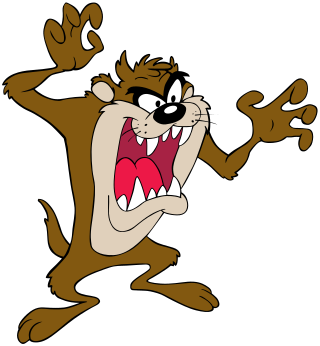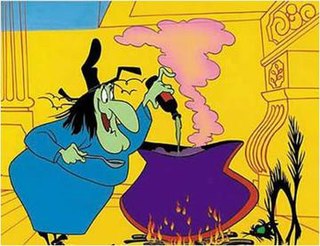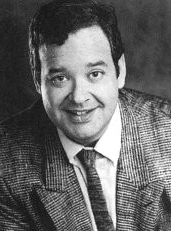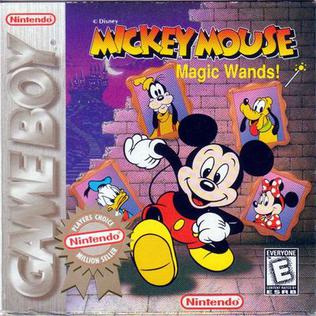
Looney Tunes is an American animated franchise produced and distributed by Warner Bros. It began as a series of short films that originally ran from 1930 to 1969, concurrently with its partner series Merrie Melodies, during the golden age of American animation. Following a revival in the late 1970s, new shorts were released as recently as 2014. The two series introduced a large cast of characters, including Bugs Bunny, Daffy Duck, and Porky Pig. The term Looney Tunes has since been expanded to also refer to the characters themselves.

Wile E. Coyote and the Road Runner are a duo of cartoon characters from the Looney Tunes and Merrie Melodies series of animated cartoons, first appearing in 1949 in the theatrical cartoon short Fast and Furry-ous. In each episode, the cunning, devious and constantly hungry coyote repeatedly attempts to catch and subsequently eat the Road Runner, but is always humorously unsuccessful in doing so. Instead of his animal instincts, the coyote uses absurdly complex contraptions to try to catch his prey. They comically backfire, with the coyote often getting injured in slapstick fashion. Many of the items for these contrivances are mail-ordered from a variety of companies implied to be part of the Acme Corporation.

Speedy Gonzales is an animated cartoon character in the Warner Bros. Looney Tunes and Merrie Melodies series of cartoons. He is portrayed as "The Fastest Mouse in all Mexico" with his major traits being the ability to run extremely fast, being quick-witted and heroic while speaking with an exaggerated Mexican accent. He usually wears a yellow sombrero, white shirt and trousers, and a red kerchief, similar to that of some traditional Mexican attires. To date, there have been 46 theatrical shorts made either starring or featuring the character.

Sylvester J. Pussycat Sr. is a fictional character, an anthropomorphic cat in the Looney Tunes and Merrie Melodies series of cartoons. Most of his appearances have him often chasing Tweety Bird, Speedy Gonzales, or Hippety Hopper. He appeared in 103 cartoons in the golden age of American animation, lagging only behind superstars Bugs Bunny, Porky Pig, and Daffy Duck. Three of his cartoons won Academy Awards, the most for any starring a Looney Tunes character: they are Tweetie Pie, Speedy Gonzales, and Birds Anonymous.

Yosemite Sam is a cartoon character in the Looney Tunes and Merrie Melodies series of short films produced by Warner Bros. His name is taken from Yosemite National Park in California. He is an adversary of Bugs Bunny and his archenemy alongside Elmer Fudd. He is commonly depicted as a mean-spirited and extremely aggressive, gunslinging outlaw or cowboy with a hair-trigger temper and an intense hatred of rabbits, Bugs in particular. In cartoons with non-Western themes, he uses various aliases, including "Chilkoot Sam" and "Square-deal Sam" in 14 Carrot Rabbit, "Riff Raff Sam" in Sahara Hare, "Sam Schultz" in Big House Bunny, "Seagoin' Sam" in Buccaneer Bunny, "Shanghai Sam" in Mutiny on the Bunny, "Von Schamm the Hessian" in Bunker Hill Bunny, "Baron Sam von Schpamm" in Dumb Patrol, and many others. During the golden age of American animation, Yosemite Sam appeared as antagonist in 33 animated shorts made between 1945 and 1964.

The Tasmanian Devil, commonly referred to as Taz, is an animated cartoon character featured in the Warner Bros. Looney Tunes and Merrie Melodies series of cartoons. Though the character appeared in only five shorts before Warner Bros. Cartoons shut down in 1964, marketing and television appearances later propelled Taz to new popularity in the 1990s.

Witch Hazel is an animated cartoon character in the Warner Bros. Looney Tunes and Merrie Melodies series of cartoons and TV shows. Witch Hazel is a fairy tale witch antagonist with green skin, a round figure, bulbous facial features, and a single tooth. The name is a pun on the witch-hazel plant and folk remedies based on it.

Joseph Francis Alaskey III was an American actor and comedian. He was one of Mel Blanc's successors at the Warner Bros. Animation studio until his death. He alternated with Jeff Bergman, Greg Burson, Jim Cummings, Bob Bergen, Maurice LaMarche, and Billy West in voicing Warner Bros. cartoon characters such as Bugs Bunny, Daffy Duck, Porky Pig, Sylvester, Tweety, Elmer Fudd, Yosemite Sam, Foghorn Leghorn, Pepé Le Pew, Marvin the Martian, Speedy Gonzales, Wile E. Coyote, Road Runner and Taz, among many others. He also voiced Plucky Duck on Tiny Toon Adventures from 1990 to 1995. Alaskey was the second actor to voice Grandpa Lou Pickles on the Nickelodeon cartoon Rugrats. He voiced Lou again in the Rugrats spin-off series All Grown Up!.

Mickey Mouse: Magic Wands!, known in Japan as Mickey Mouse V: Mahou no Stick and known in Europe as Mickey Mouse V: Magic Wands!, is a puzzle/action game hybrid developed and published by Kemco in Japan on December 22, 1993. It was later published in North America and Europe by Nintendo in May 1998 in a version featuring Super Game Boy support. It is the fifth installment in the Crazy Castle series.

The Crazy Castle series is a platform game series created by Kemco and released on the Famicom Disk System, Nintendo Entertainment System, Game Boy, Game Boy Color, and Game Boy Advance. It stars different popular cartoon characters, most notably the Warner Bros. cartoon character Bugs Bunny, the Walt Disney cartoon character Mickey Mouse and the Universal cartoon character Woody Woodpecker.

Kid Klown in Night Mayor World is a platform video game for the NES published by Kemco on April 1, 1993 and was the first game in the Kid Klown series. It was a reskin of Mickey Mouse III: Yume Fuusen, a licensed platform video game starring Mickey Mouse that was only released in Japan. Released as part of the Crazy Castle series, Mickey Mouse III was released on September 30, 1992 by Kemco in Japan for the Family Computer.

Tweety's High-Flying Adventure is a 2000 American animated musical slapstick comedy film produced by Tom Minton and James T. Walker, written by Tom Minton, Tim Cahill and Julie McNally, and directed by James T. Walker, Karl Toerge, Charles Visser, and Kyung Won Lim, starring Tweety.

Kids' WB Fun Zone is a themed attraction in Warner Bros. Movie World on the Gold Coast, Queensland, Australia based on the Looney Tunes cartoons. The attraction was originally named Looney Tunes Village and was renamed in late 2007 when two new rides were added. At the same time, the Australian Kids' WB TV show began filming at the theme park. Two similar themed attractions, Looney Tunes Land and Cartoon Village, opened at Warner Bros. Movie World Germany in Bottrop Kirchhellen, Germany in 1996 and Parque Warner Madrid in Madrid, Spain in 2002, respectively, with the latter remaining to this day.

Bugs Bunny: Crazy Castle 3, is a platform game developed by Kemco as part of the Crazy Castle series. It was originally released in Japan as a Game Boy title in July 1997 called Soreyuke!! Kid: Go! Go! Kid starring the character Kid Klown. The title was later remade on the Game Boy Color to include colorized graphics and characters from the Looney Tunes series, which was released in Japan in January 1999 by Kemco, and later that year in North America and Europe by Nintendo. It replaces Honey Bunny with Lola Bunny as Bugs' love interest to be rescued. It was followed by a sequel, Bugs Bunny in Crazy Castle 4, in 2000.

The Bugs Bunny Crazy Castle 2, known in Japan as Mickey Mouse II, and in Europe as Mickey Mouse or Hugo, is a video game originally developed by Kemco for the Game Boy in 1991. It is the sequel to the 1989 Nintendo Entertainment System and Game Boy game The Bugs Bunny Crazy Castle.

Looney Tunes: Cartoon Conductor is a Nintendo DS game developed by Amaze Entertainment and published by Eidos Interactive.

The Looney Tunes Show is an American animated sitcom produced by Warner Bros. Animation, and aired on Cartoon Network for two seasons from May 3, 2011, to November 2, 2013. The series differed from others featuring characters from the Looney Tunes, by focusing on stories conformed around a sitcom format involving the characters of Bugs Bunny and Daffy Duck, who live a surburban life together within a neighborhood of fellow cartoon neighbors, dealing with various issues in their own way. Both the characters from the Looney Tunes, as well as the Merrie Melodies theatrical cartoon shorts, were given a 21st century update, with episodes also including a musical short; the first series also included computer-animated shorts involving new antics between Wile E. Coyote and the Road Runner.
Bugs Bunny's Birthday Ball is a 1990 pinball game designed by John Trudeau and Python Anghelo and released by Midway. It is based on Warner Bros.' Looney Tunes and Merrie Melodies series of cartoons. This is the first of only two licensed pinball tables ever to feature the Looney Tunes characters.

Bugs Bunny in Crazy Castle 4 is a platform game developed by Kemco as part of the Crazy Castle series. This is the first game in the series to feature the Bugs Bunny character in all of its versions, and the last one to be published under that license.

















